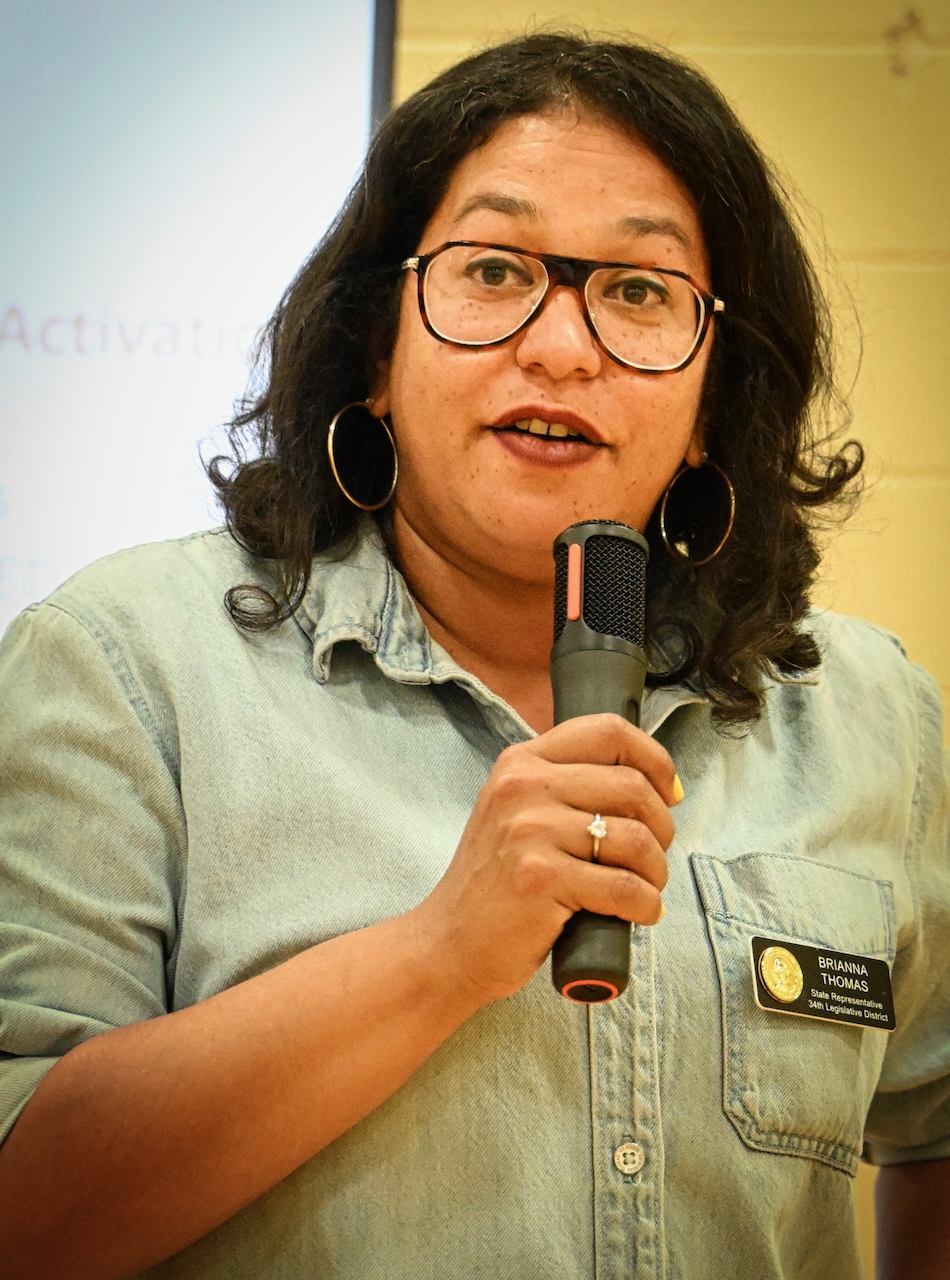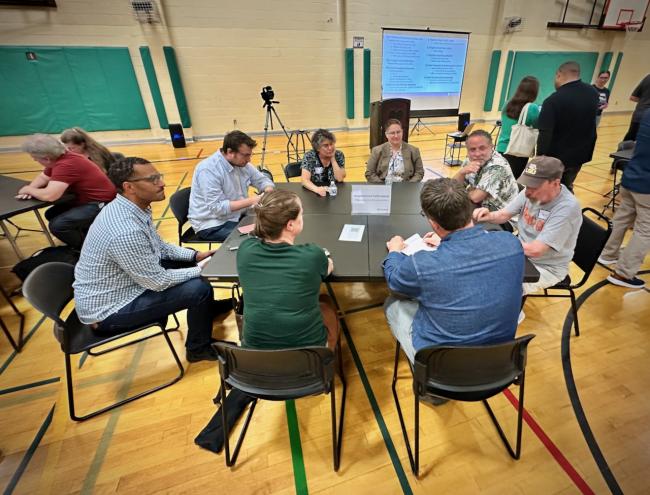Community Safety forum was a chance to assess and seek answers from leaders
District 1 City Council Member Rob Saka sat at a table focused on traffic safety during the "Creating a Safer Seattle Public Safety Community Forum" on August 14th.
Photo by Patrick Robinson
Fri, 08/15/2025
On August 14th, the "Creating a Safer Seattle Public Safety Community Forum" convened at the Delridge Community Center, bringing together city leadership and community members to discuss public safety and health solutions within the framework of the One Seattle Restoration initiative. The forum served as a platform for collecting community feedback and outlining the visions of various departments involved in ensuring a safer city.

Council Member Rob Saka for District 1 opened the forum, emphasizing the paramount importance of public safety to his constituents. Saka highlighted that "public safety is actually the number one query or concern or question or piece of feedback that my office hears regularly from my constituents, you all, our neighbors across West Seattle, Pioneer Square, Georgetown, and South Park". He committed to his role as a legislator, stating, "I take my responsibility seriously to make laws, make investments appropriate to the budget process and appropriations process and also most importantly advocate on your behalf directly to the three teams here ... to help us do more".
Police Chief Shon Barnes of the Seattle Police Department (SPD) presented his vision for "Seattle Center Policing," a plan developed and reviewed by various stakeholders, including the Mayor's office, and validated by national scholars. Chief Barnes underscored the necessity of partnership, asserting that "the police cannot reduce crime alone. It takes partnership with other people". He stressed the importance of transparency in communication, stating, "People can only participate in their own public safety when we're transparent about the things that are going on".
He also noted significant progress in recruitment and retention, with 17 officers hired this year, nearing the 24 hired last year, and reported reductions in violent crime, property crime, shots fired (21%), and homicides (29%). Addressing community concerns about online crime reporting, Chief Barnes acknowledged the need for improvement, saying, "If we could make some tweaks to it, it would be adding some procedural justice. It would be improving the customer service experience".
Fire Chief Harold Scoggins of the Seattle Fire Department (SFD) detailed his department's mission to "saving lives, protecting property, and the environment". He highlighted SFD's national leadership, particularly in emergency medical services, noting, "We have the highest cardiac save rate in the country. So, you have a higher probability of being sick from at event here in Seattle than you do anywhere else in the nation". He proudly mentioned the pioneering work of their mobile integrated health team, Health One, stating, "When we started that program in 2019, we were one of the first folks in the nation to do it", and that Seattle's paramedics and EMTs were the first in the state and nation, respectively, to administer buprenorphine for overdose. Chief Scoggins also reported a record 112,000 responses in 2024, the highest in the department's history. He explained efforts to improve fire safety awareness through various community programs, including "story time," public safety fairs, and outreach to senior living facilities via community fire safety advocates.
To address growing demands, SFD has added resources like a secondary ladder truck in West Seattle and an additional MedicAid unit in South Park. The implementation of a nurse line at the 911 dispatch center in 2022 has diverted 7,000 lower-level medical calls, and the Health One team diverted nearly 4,000 calls last year, allowing traditional units to remain available for critical emergencies.
Chief Dr. Amy Barden of the CARE Department discussed the department's structure, which includes Seattle 911, CARE crisis responders, and a third division focused on community violence interruption. Her vision is to "build out that continuum that we know we need law enforcement for some calls. We need police co-response for some calls... All of those lower community calls in the middle. There's social work in nature. We don't think there should be a response". Chief Barden emphasized the critical need for equitable support for the CARE department, stating, "It is really important that the pure department is co-equal and supported in unequal ways. It's one thing to talk about it, it's another thing to fund it".
She reported the 911 center handles about 900,000 calls annually, with approximately half not requiring traditional first responders. She also detailed 911 response times, noting that priority one calls (urgent for life) are assigned within 45 seconds, while priority two calls (emergencies that could worsen) have an average response time of 22 minutes, and priority three calls (suitable for CARE) may take several hours due to prioritization of more urgent incidents. When discussing addressing drug use, Chief Barden advocated for a philosophy of "intervention first and then deflection... Then diversion". She concluded by asserting the need to differentiate between punishment and accountability, stating, "We've got to stop conflating punishment and accountability. We all need accountability. It's possible to change if you don't have a consequence. That is not the same thing as punishing someone and wanting them to sit in their shame in their loss and their feeling like their life has no value".

State Representative Brianna Thomas for the 34th legislative district, also addressed the forum, highlighting collaboration between state and city government. She specifically mentioned her work with Chief Barton on House Bill 1816, which aims to "make the care department permanent in the eyes of the state". This bill is crucial as the department currently operates under a temporary Memorandum of Understanding (MOU) set to expire at the end of the year.
Following the presentations, attendees were invited to participate in individual table discussions, organized around the One Seattle Restoration Framework, allowing them to provide direct feedback on specific public safety and health topics. The chiefs moved between tables, engaging directly with community members.
The topics of focus at these tables and the city department representatives responsible for each area included:
• Gun Violence Prevention & Reduction
◦ Seattle Police Department (SPD), Gun Violence Reduction Unit, Relational Policing Unit, Community Service Officer (CSO), Human Services Department (HSD), HSD Safe and Thriving Communities.
• High Impact Crime Reduction
◦ Seattle Police Department (SPD).
• Effective Emergency Response
◦ CARE Department (9-1-1, CARE crisis responder), Seattle Fire Department (SFD), Seattle Police Department (SPD).
• Substance Use Disorder Response
◦ Seattle Fire Department — Health 1 & Health 99, CARE Crisis Responder.
• Neighborhood Traffic Safety
◦ Seattle Department of Transportation (SDOT).
• Neighborhood Park Safety
◦ PARKS Rangers.
• Neighborhood Beautification
◦ Unified Care Team (UCT), Seattle Public Utilities (SPU).
• Crime Prevention & Small Business Activations
◦ Seattle Police Department (SPD), Crime Prevention Coordinators, Office of Economic Development (OED).
• Youth & Community Investments
◦ Human Services Department (HSD), Department of Early Education Learning (DEEL).
Department of Neighborhood liaison staff were also present at the tables to gather input and respond to questions


